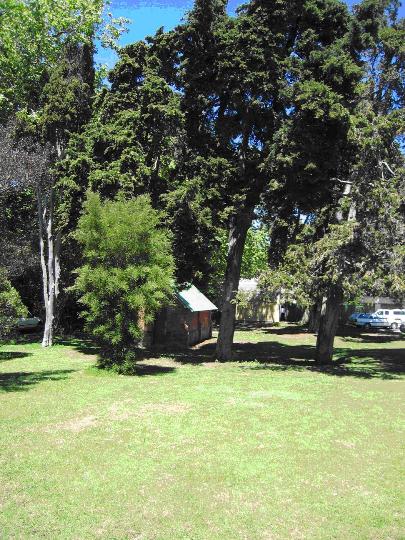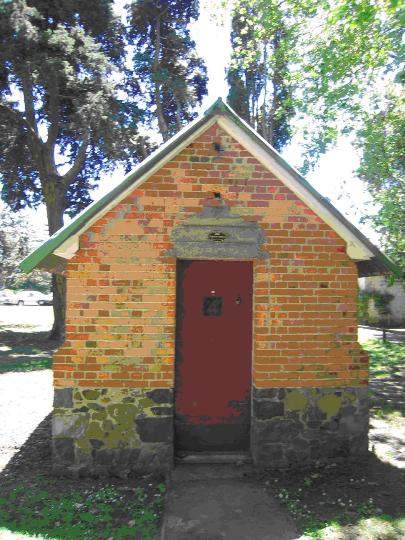Historic photographs show that aside from the Provincial Buildings, the brick magazine was the earliest building on the site of Albion Square. Erected in approximately 1861 it was likely used by local militia when they had their barracks in nearby Harley Street. Military in early New Zealand In 1845 the government, prompted by clashes with Maori in the North and South of the country - in particular Hone Heke's rebellion in July 1844, issued its first Militia Ordinance. This allowed for militia units to be raised in emergencies and that for all able bodied men between 18-65 to be ready for service and for training of 28 days per year. Militia battalions were formed in Auckland, Wellington and Nelson where settlers had born witness to, or feared, Maori attacks. After some initial skirmishes in Auckland and Wellington there was little militia activity for many years. There was a small outbreak near Wanganui in 1847, dealt to by imperial forces, and a dispute between Maori over land near New Plymouth in 1854 prompted the founding of a force there in 1855. In 1858 a Militia Act, similar to the Militia Ordinance, was passed by the New Zealand Parliament. This act allowed for the continuation of militia forces, allowing for militiamen to find substitutes, it also made provision for volunteer units. Volunteers were exempted from militia service but were required to serve anywhere in New Zealand. The country was divided into militia units and permanent training staff provided for each district. They were to train all militia and volunteer units in their district. Almost every settlement formed its own volunteer corps, leading to the appointment of a Deputy Adjunct-General in 1859. The total force of volunteers in the 1860s was said to be approximately 6000 but very few of the volunteer corps ever took part in campaigns. Each officer and 'efficient volunteer' was paid an annual capitulation grant but with no prescribed training, many of the corps drilled only sporadically, often only leaving their drill halls for ceremonial parades. Recommendations to improve the efficiency of the corps were made but nothing was done for many years. Two scares of war between Britain and Russia in 1878 and 1885 (and again later in 1895), the 'Russian scares', and subsequent concern over the possibility of a Russian invasion in the colonies prompted the New Zealand government to look at the country's preparedness. An 1880 report from Colonel Scratchley on New Zealand's coastal defences recommended the construction of a system of coastal defences and the reorganisation of volunteer corps as small field forces around the port cities of Auckland, Wellington, Lyttelton and Dunedin. These recommendations were implemented in 1882. In the late 1890s there were gradual improvements to efficiency, as the recommendations of a report by Commandant Lieutenant Colonel Fox on the volunteers corps were enacted. In 1899 some volunteer units served in the South African War. These improvements and those made in the early 1900s were not deemed sufficient. On his retirement in 1906 General Officer Commanding Major General Babington commented that the colony did not take its defence seriously. As a result of his comments a Defence Council was formed in 1907. In their first report they commented that 'volunteering had had its last chance', with the only practical alternative being compulsory military training. Compulsory military training was introduced under the auspices of the Defence Act 1909 and the territorial army, which would replace the Volunteers, was formed in 1910-1911. Military in early Nelson The Nelson Battalion of Militia was formed in Nelson in August 1845, shortly after the first militia ordinance was issued. It formation stemmed from concern that Maori were going to attack, it was not a concern without foundation the settlement some two years earlier having born witness to the Wairau affair (see Appendix Six of the Albion Square Registration Report - survey test marks for further discussion). The militia saw no active service at this time. After this period little is known about the activities or structure of the militia in the area. It is known that voluntary training commenced in Nelson in 1860, and given the timeframe it was this that possibly prompted the building of the magazine in Albion Square. On the introduction of the Territorial Army in 1911 the existing infantry in Nelson was regrouped becoming the 12th Regiment in the Canterbury Military District. Use of the magazine The brick magazine that remains in Albion Square today was erected there in approximately 1861, possibly influenced, as outlined above, by the formation of volunteer corps in the area. It sits directly to the north of the Fire Engine House and, as indicated, it is built of stout materials, primarily brick. Prior to the erection of this magazine it is thought that a magazine on the Boulder Bank was in use. Although the brick magazine was built on Section 203 in approximately 1861 the land was not acquired by the Crown until 1866, and not handed over for public utility until 1871. By 1880 there were two magazines within Albion Square. The other magazine no longer remains but once sat directly to the south of the Fire Engine House. It is thought to have been a more temporary construction; recorded as a timber and iron building it is referred to as the timber magazine in this discussion. As discussed little is known about the early military in the area and less still about their use of the magazines during the Provincial Government era. Butterworth, in her book on the Suter Art Gallery, notes that 'local tradition says [the brick magazine] was used as a temporary cell to hold the 'Maungatapu murderers' upon their arrest'. No records have been found to support this, though interestingly folklore also suggests that the bodies of those murdered were displayed in the nearby Fire Engine House (see Appendix Six of the Albion Square Registration Report - Fire Engine House for discussion of the Maungatapu murders). Records relating to the use of the magazines tell only of their use in the early to mid 1900s. Of interest among this material are records relating to the problems associated with the timber magazine to the south of the Fire Engine House and the probable disuse of the brick magazine as a magazine. Correspondence indicates that during 1904 the wooden floor of one of the magazines, referred to as the small arms magazine, gave way when soldiers were placing ammunition in it. Subsequent correspondence indicates that this was the timber magazine to the south of the Fire Engine House. The floor of the timber magazine was subsequently repaired and it appears to have been reused with correspondence from 1905 expressing concern that the timber magazine may catch on fire because of sparks from the forge at the nearby Technical School. A brick surround was subsequently erected around the base. The timber magazine appears to have been demolished prior to 1936 to make way for the Ministry of Works paint shop erected in the late 1930s to early 1940s. Correspondence regarding the brick magazine to the north of the Fire Engine House is more limited. The Director of Artillery after visiting the brick magazine wrote, in August 1907, a report critical of the storage of ammunition in the magazine, in particular the storage of dynamite and field gun ammunition stored together, which he saw as against regulations and dangerous. He was particularly concerned because of the structure's close proximity to the Central city. He noted: "The building is practically in the centre of the city, and I believe if the City Council were aware of the contents of the building they would prohibit its use entirely as a magazine...Personally, I am of the opinion that it unnecessary to keep a large reserve of FG [field gun] ammunition in Nelson as I do not think there would ever be use for a Field Battery in that District, but that its services would be required at one of the defended ports in time of war, therefore the reserve ammunition for this Battery should be kept at Wellington. All that is required is to keep about 200 rounds in the District, Viz:- the annual allowance for practice". He suggested that it would be wiser to store the ammunition at a greater distance, for example at Boulder Bank. Enquiries were made into a suitable site outside of the city boundary and with Boulder Bank appearing the most suitable and least expensive. It is unknown if this brick magazine was used for the storage of ammunition after this time.


Location
List Entry Information
Overview
Detailed List Entry
Status
Listed
List Entry Status
Historic Place Category 2
Access
Private/No Public Access
List Number
5161
Date Entered
2nd February 1990
Date of Effect
2nd February 1990
City/District Council
Nelson City
Region
Nelson Region
Location Description
Located in the Albion Square Historic Area which is bounded on the north and south side by Hardy Street and Bridge Street, Nelson.
Stay up to date with Heritage this month
